[Editorial Note: This post has sat incomplete for almost three years because I was trying to stitch together some very big and complicated concepts spanning roughly 2600 years. Coming back to this and trying to figure out what I wanted to say, I figured out that the real uniting theme and thesis is {Marge Simpson voice} “I just think they’re neat!”]
A while back I had an idle thought that stuck in my head. In the last several posts, I talked a lot about colonial money systems and, for America, the not-so-great transitional money that we used during the Revolutionary War, the Continental. In February 2019, a weird post-Soviet collapse commodity token came into my possession which led me to ask myself what happened to the money during the Russian Revolutions of 1917 and the subsequent Russian Civil War? I have post-1940s Soviet currency and coins in my collection, but there had to be a period where the Tsar’s ruble was still common and I assume no Bolshevik worth their red banner was going to use anything with a Romanov crest on it. Did they just stamp a hammer and sickle across the old coins (AKA overstriking)? What did they run their economy with at the dawn of GLORIOUS SOVIET STATE!?!?
What I was asking about a is very particular modern case of one of my favorite arguments in favor of coin collecting: money’s importance to the historical record in telling us stories from the peoples and nations of the past. For some civilizations and eras, their coins may be all we know about them. But like all kinds of intelligence gathering, the absence of a thing or conflicting evidence is almost as telling as a definitive information. Today, I’m going to be talking about Money When Everything Falls Apart.
IMPORTANT CAVEAT: since the dawn of money itself until very recently, the economic basis and power of country’s currency was based on the purity of it’s precious metal content, with gold being most valuable, then silver, and then copper/brass/etc. Also, their economies were strictly cash systems without much in the way debt and finance that are so common today until the 1600s (no, I don’t want to talk about the Templars). I am not arguing for or against the gold/silver standard here but I am quite clear that our ancestors believed in it and that influenced their actions with historical consequences.
During periods of turmoil, when there is weak/poor leadership, civil war, or invasion, there is usually a corresponding collapse of the coinage, either in quantity or quality. There may be rapidly changing coin designs, usually because a new leader means a new coin. There may be leaders from whom we never find coins because:
- They were all destroyed to damn the memory of that leader.
- They were all recollected to melt down and re-mint as either higher bullion content, or the same but debased instead.
- The treasury was carted off as booty and the government subsequently fell.
Similarly, we find coins with unknown leaders on them because:
- They were a leader who’s memory was damned, striking them from the domestic record, but some coins were buried in hordes or paid to mercenaries during their rule, circulating beyond the borders of the country where they’ve been intentionally forgotten.
- In a bid to gain legitimacy, they were coins issued by rebellions that then failed.
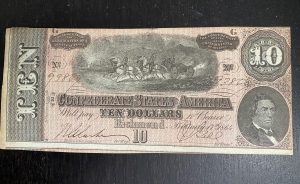
Of course, there’s also the possibility that the coin you found isn’t legitimate currency. Counterfeits aren’t just a swindle by the unscrupulous, they can also be a weapon of war. From the American experience during the American Civil War, “Honest Sam” Upham made enough counterfeit Confederate currency that a considerable percentage of the circulating bills during the early war were his, destabilizing the Confederate economy. The Lincoln Administration was very uncomfortable with tacitly supporting this, by which I mean not arresting him, because what would stop Sam from doing the same to the Union? And if the Lincoln Admin was merely uncomfortable, the Davis Administration’s reaction was to instate the death penalty for counterfeiting because he may have “done more damage to the Confederate cause than McClellan and his army”. Please ignore how lackluster McClellan’s performance was in this metaphor, also that Grant & Sherman hadn’t happened to them yet in 1862.
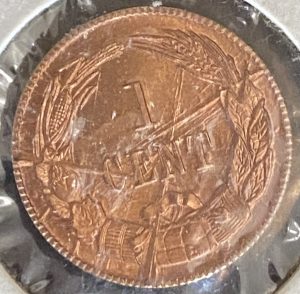
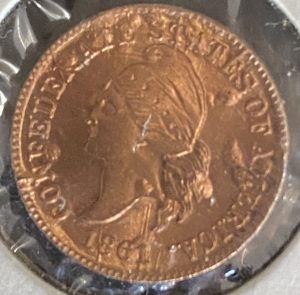
You see, the Confederacy was extremely dependent on their paper money. They didn’t have much precious metal to make coins with and the only functional mint in the Confederacy was the small one in New Orleans (Dahlonega and Charlotte mints had been defunct for a couple decades at this point). Louisiana seceded from the United States in January 26, 1861 and by the end of April of that year they were completely out of bullion to work with, having struck all their coins with the old United States of America dies. Which is to say, they ran out before the Confederacy was really born and it never came back. The gold & silver rushes out in the west were on but none of that bullion was going to the Confederacy. And Gen. Winfield Scott’s last military contribution before dying, the Anaconda Plan AKA the Blockade, made certain that that no foreign bullion was ever going to show up. Theoretically, the Confederacy designed new coins out of pride, a penny and a half-dollar, but these never saw circulation. The example to the right is a restrike in my collection, made from the copies of the Confederate’s original dies that were so shoddily made that they cracked and chipped after just a few test uses. All this is to say future archaeologists will find no coin evidence that the Confederacy’s brief existence ever happened; the Confederate paper money, counterfeit and legitimate, will have all rotted away and the coins say it’s been the United States of America the entire time.
When the Russian Revolution/Civil Wars came, the largest contiguous nation on Earth fragmented in a spectacular and very Russian manner. I find that when the anglophone world thinks of civil wars, we tend to think in terms of a Star Wars-like Empire vs. Rebels dichotomy. That’s so cute and simplistic. Russia is here to teach you that you can not only have multiple sides in your civil war but that any given side can have multiple factions within it that bitterly hate each other. Let me start by trying to describe the factions in very simple terms:
- The Whites – The defenders of the Tsarist imperial order. Not necessarily supporters of Tsars, but of the order and privileges of the Ancien Regime.
- The Blues – The proponents of a more democratic, representative Russian state. Kinda.
- The Reds – The Bolshevik and other communist factions. TL;DR history, the Bolsheviks won.
- The Greens – The peasant movement that mostly wanted armies stop wandering all over the place like Trogdor, making life miserable for peasants.
- The Blacks – The Ukrainian anarchist movement to make a stateless state.
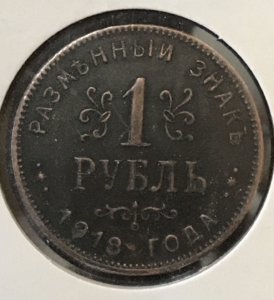
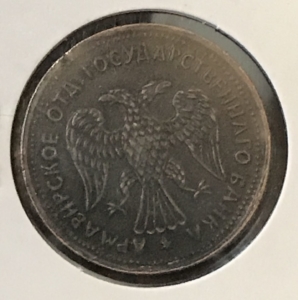
After some very promising victories, The Army of Don/Southern White Russian forces assembled a massive chunk of territory in the Caucasus and steppe lands near Crimea, driving out the soviets in control of the cities there. This is as close as they every got to being a nation of any kind, rather than some armies made mostly of Cossacks with a leadership full of serious reactionary grudges. Feeling proud of their achievements and trying to show some legitimacy, they managed to issue copper coins with a modified Romanov crest from their base of operations in Armavir. Note the double headed eagle without crown. This is supposed to signify a Russia without the Romanovs holding power as Tsars over it (no crown on the Romanov eagle). But this was something of a half-hearted effort, you can tell how rough this design is, as they assumed they’d be back in St. Petersburg in no time, with a proper mint, engravers, and bullion at their disposal.
Meanwhile, out in the Far East, Baron Roman von Ungern-Strernberg was trying to become a newer and whiter khan, paying for his armies in the preferred currency out there. We’ve discussed it before, the trusty ol’ Spanish 8 reales, which was still the most trusted coin in the world. So, yes, pieces of eight for his newly assembled Altai & Mongol horde. The Bloody Baron never minted any coins of his own because why bother with such trivialities when you’re an incarnation of the God of War. If you aren’t already familiar with the Baron, I do recommend reading about one of the more colorful characters in the Russian Civil War, occult studies, and not at all sane archaeology. It’s one of those names you keep tripping across in Weird History of the 20th Century and features in the Charlie Stross’ The Fuller Memorandum in The Laundry Files series.
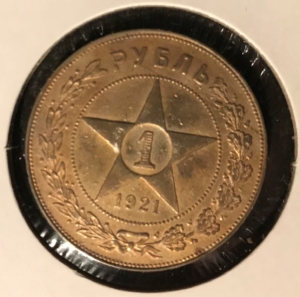
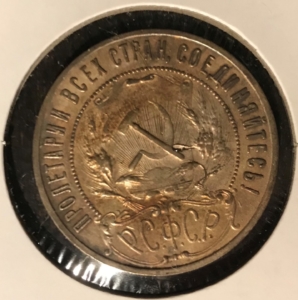
Meanwhile, how did the Bolsheviks pay for everything? ANSWER: They didn’t. From 1917-1921, the Bolsheviks minted no coinage. What they did have was guns, land reform, and requisitions under the precepts of War Communism, many parts of which never really went away once they started. Except the result of all the requisitions was a certain level of “Why grow anything if the Bolsheviks will just take it?” nihilism. This, in turn, contributed to a series of starvation events throughout the former Russian Empire during the 1920s and 30s, like the Holodomor in Ukraine for the worst example.
Once all the White factions were eliminated, for given values of “crushed” (ahem, Finland), then the Russian Soviet Federative Socialist Republic minted new rubles. But in 1921, it wasn’t the USSR yet, just a federation of Russian soviets, but don’t worry revolution was Russia’s leading export. The RSFSR transitioned into the USSR the following year so this was also a coin that only existed as legal tender for a matter of months. The Armavir & RSFSR rubles are both tangible snapshots of transitory nations, one that never was and one that quickly morphed into another.
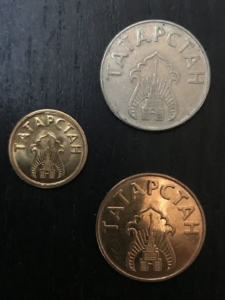
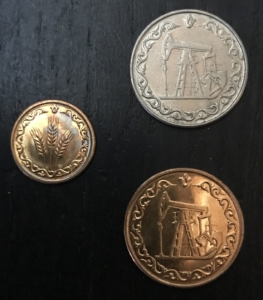
Fast forward 70 years to the coins that started my exploration. The collapse of the Soviet Union means NEW COINS FOR EVERYONE! Or at least you better mint some really quickly if you intend to be your own nation again. And, as happens a lot when things fall apart, the economy doesn’t collapse exactly because all the need and means of production were all still there, just missing a means of exchange to facilitate it. A Russian researcher who lived through it all in Leningrad had a joke that goes “No need to worry about not using the old money any more. There wasn’t anything to buy anyway.” [bad Russian accent] Very funny joke, you laugh.
But as previously noted, the Russian Empire and then the Soviet Union were the largest contiguous nations on Earth but there’s a whole lot of not near the centers of power. One of the details missed in teaching the history of the Russian Empire and Soviet Union is how many small semi to almost entirely autonomous states were contained inside the giant red blob on the map labeled USSR. Part of this was revolution and civil war leftovers of smaller regions making their own soviets and then later joining the Russians to become the USSR. That, in turn, was a leftover from the older autonomous regions stitched together to make the fiction of the Russian Empire. Trying to manage anything as large as Russia from St. Petersburg prior to the advent of modern telecommunications was a whole lot of nodding and smiling of “Yes, we serve the Tsar faithfully but he is far away.” If you remember the 1992 Olympics with the Commonwealth of Independent States representing the athletes from the former Soviet Union, that was a bit of the compromise to cover all the not yet resolved borders and and sovereignty arguments from dissolution.
Tartarstan was one of those many regions that tried to go independent during the civil war and then got reeled into the USSR. During the Glasnost era, they were declared an autonomous soviet socialist republic within the greater USSR and then shortly thereafter were on their own with dissolution of the USSR as whole, with no remains of a central bank to call on. Trying to maintain basic support for their citizens, they issued a series of commodity based tokens for rations/some medium of exchange made by the Yugoslavian Mint (by which I mean the Federal Republic of Yugoslavia under Milošević, as Yugoslavia proper had ceased to exist a few years earlier). They came in the “denominations” of 1 kilo of bread, 10L of petrol, and 20L of petrol coins with helpful iconography to let you know what they were for. For added fun, the 10L copper toned petrol coin got taken out of circulation quickly because enterprising souls had been nickel plating it to look like the 20L version. In 1994, Tartarstan rejoined Russia as an autonomous republic, signing the agreement with Tartarstan’s native son, Russian President Boris Yeltsin. This gave Tartarstan a full set of currency tied to a large economy…such that it was at the time.
The sad coda is that Tartarstan was the last autonomous republic within Russia to lose their autonomous status. The Kremlin under Putin decided to not renew the autonomy agreement, quietly letting it expire in 2017 as both the United Nations and Russia decided to ignore their request for recognition of sovereignty.